Emirates Airlines: Analyzing Growth, Strategy, and Key Success Factors
VerifiedAdded on 2023/04/23
|16
|4013
|349
Case Study
AI Summary
This case study delves into the remarkable success of Emirates Airlines, highlighting its strategic growth, key factors, and the pivotal role of Dubai as its mega hub. It examines how Emirates capitalized on emerging markets, implemented innovative technologies like Flex Tracks, and carefully planned routes to tap into underserved regions. The study also emphasizes the support from the UAE government through bilateral aviation agreements and infrastructure investments. Furthermore, it analyzes Emirates' influence on aircraft design, its fleet management strategies, and its focus on premium customer experiences. The case study includes a SWOT analysis, revealing the airline's strengths, weaknesses, opportunities, and threats within the competitive airline industry. Emirates' collaboration with Dubai's tourism sector and strategic positioning at the crossroads of major passenger flows are also discussed as critical elements contributing to its global success. Desklib provides access to similar case studies and solved assignments for students.
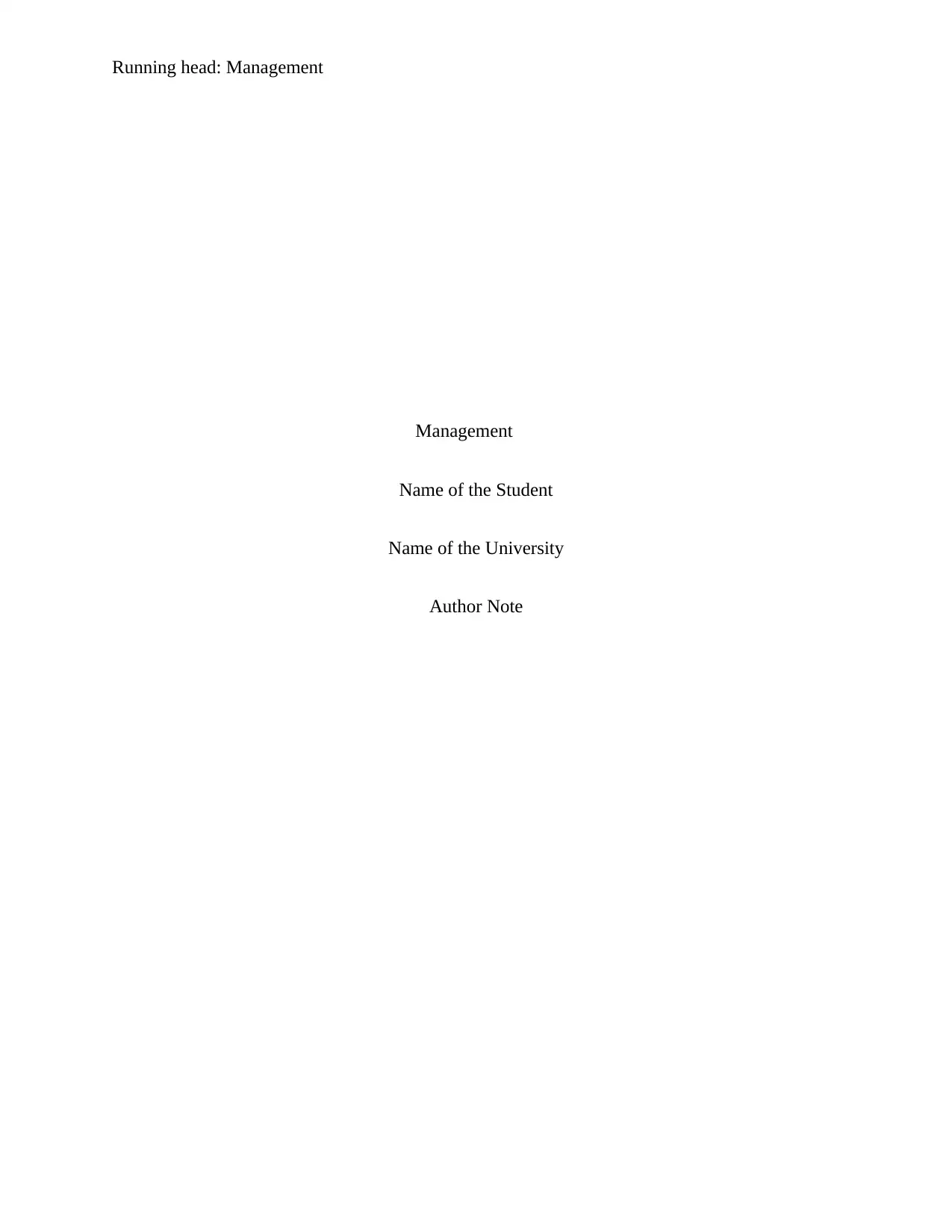
Running head: Management
Management
Name of the Student
Name of the University
Author Note
Management
Name of the Student
Name of the University
Author Note
Paraphrase This Document
Need a fresh take? Get an instant paraphrase of this document with our AI Paraphraser
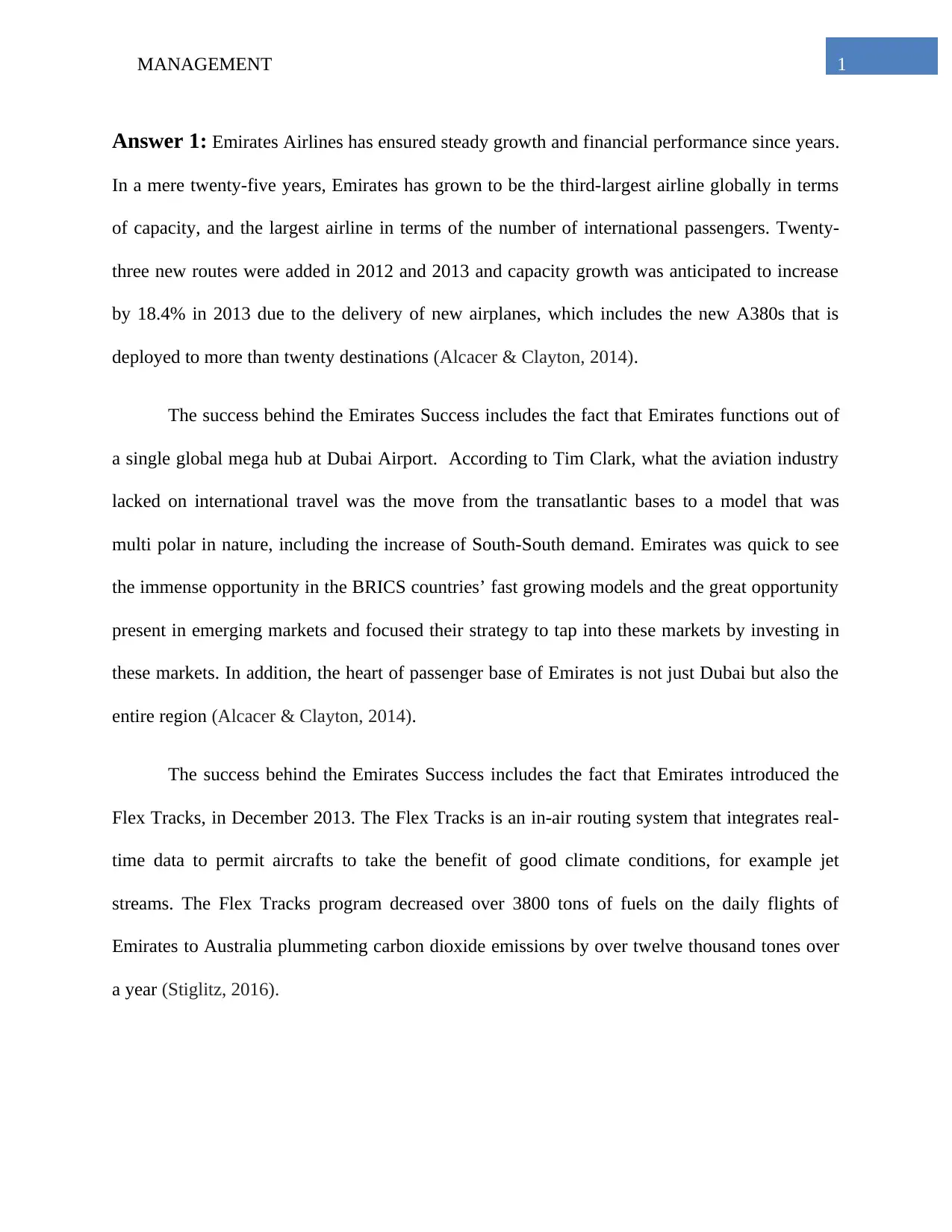
1MANAGEMENT
Answer 1: Emirates Airlines has ensured steady growth and financial performance since years.
In a mere twenty-five years, Emirates has grown to be the third-largest airline globally in terms
of capacity, and the largest airline in terms of the number of international passengers. Twenty-
three new routes were added in 2012 and 2013 and capacity growth was anticipated to increase
by 18.4% in 2013 due to the delivery of new airplanes, which includes the new A380s that is
deployed to more than twenty destinations (Alcacer & Clayton, 2014).
The success behind the Emirates Success includes the fact that Emirates functions out of
a single global mega hub at Dubai Airport. According to Tim Clark, what the aviation industry
lacked on international travel was the move from the transatlantic bases to a model that was
multi polar in nature, including the increase of South-South demand. Emirates was quick to see
the immense opportunity in the BRICS countries’ fast growing models and the great opportunity
present in emerging markets and focused their strategy to tap into these markets by investing in
these markets. In addition, the heart of passenger base of Emirates is not just Dubai but also the
entire region (Alcacer & Clayton, 2014).
The success behind the Emirates Success includes the fact that Emirates introduced the
Flex Tracks, in December 2013. The Flex Tracks is an in-air routing system that integrates real-
time data to permit aircrafts to take the benefit of good climate conditions, for example jet
streams. The Flex Tracks program decreased over 3800 tons of fuels on the daily flights of
Emirates to Australia plummeting carbon dioxide emissions by over twelve thousand tones over
a year (Stiglitz, 2016).
Answer 1: Emirates Airlines has ensured steady growth and financial performance since years.
In a mere twenty-five years, Emirates has grown to be the third-largest airline globally in terms
of capacity, and the largest airline in terms of the number of international passengers. Twenty-
three new routes were added in 2012 and 2013 and capacity growth was anticipated to increase
by 18.4% in 2013 due to the delivery of new airplanes, which includes the new A380s that is
deployed to more than twenty destinations (Alcacer & Clayton, 2014).
The success behind the Emirates Success includes the fact that Emirates functions out of
a single global mega hub at Dubai Airport. According to Tim Clark, what the aviation industry
lacked on international travel was the move from the transatlantic bases to a model that was
multi polar in nature, including the increase of South-South demand. Emirates was quick to see
the immense opportunity in the BRICS countries’ fast growing models and the great opportunity
present in emerging markets and focused their strategy to tap into these markets by investing in
these markets. In addition, the heart of passenger base of Emirates is not just Dubai but also the
entire region (Alcacer & Clayton, 2014).
The success behind the Emirates Success includes the fact that Emirates introduced the
Flex Tracks, in December 2013. The Flex Tracks is an in-air routing system that integrates real-
time data to permit aircrafts to take the benefit of good climate conditions, for example jet
streams. The Flex Tracks program decreased over 3800 tons of fuels on the daily flights of
Emirates to Australia plummeting carbon dioxide emissions by over twelve thousand tones over
a year (Stiglitz, 2016).
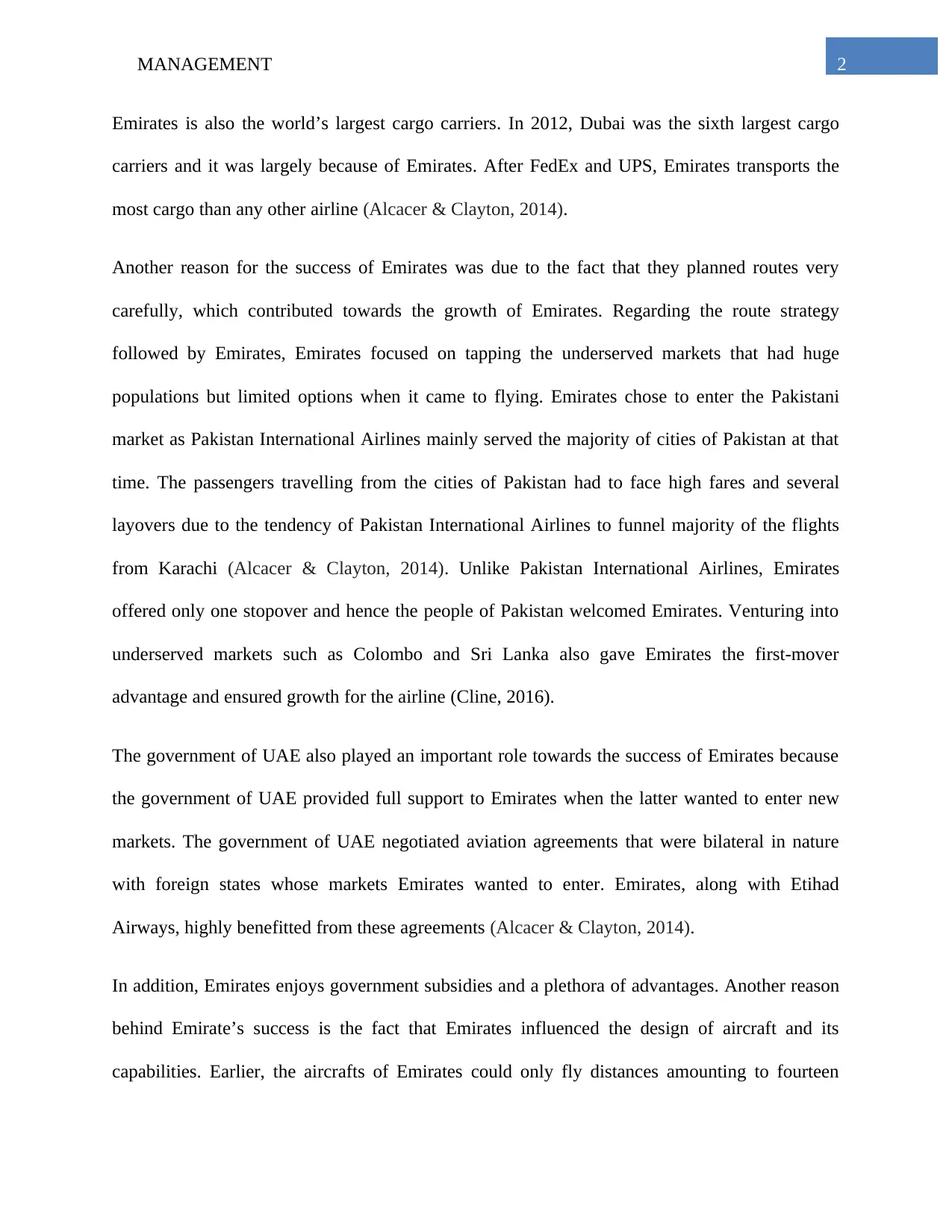
2MANAGEMENT
Emirates is also the world’s largest cargo carriers. In 2012, Dubai was the sixth largest cargo
carriers and it was largely because of Emirates. After FedEx and UPS, Emirates transports the
most cargo than any other airline (Alcacer & Clayton, 2014).
Another reason for the success of Emirates was due to the fact that they planned routes very
carefully, which contributed towards the growth of Emirates. Regarding the route strategy
followed by Emirates, Emirates focused on tapping the underserved markets that had huge
populations but limited options when it came to flying. Emirates chose to enter the Pakistani
market as Pakistan International Airlines mainly served the majority of cities of Pakistan at that
time. The passengers travelling from the cities of Pakistan had to face high fares and several
layovers due to the tendency of Pakistan International Airlines to funnel majority of the flights
from Karachi (Alcacer & Clayton, 2014). Unlike Pakistan International Airlines, Emirates
offered only one stopover and hence the people of Pakistan welcomed Emirates. Venturing into
underserved markets such as Colombo and Sri Lanka also gave Emirates the first-mover
advantage and ensured growth for the airline (Cline, 2016).
The government of UAE also played an important role towards the success of Emirates because
the government of UAE provided full support to Emirates when the latter wanted to enter new
markets. The government of UAE negotiated aviation agreements that were bilateral in nature
with foreign states whose markets Emirates wanted to enter. Emirates, along with Etihad
Airways, highly benefitted from these agreements (Alcacer & Clayton, 2014).
In addition, Emirates enjoys government subsidies and a plethora of advantages. Another reason
behind Emirate’s success is the fact that Emirates influenced the design of aircraft and its
capabilities. Earlier, the aircrafts of Emirates could only fly distances amounting to fourteen
Emirates is also the world’s largest cargo carriers. In 2012, Dubai was the sixth largest cargo
carriers and it was largely because of Emirates. After FedEx and UPS, Emirates transports the
most cargo than any other airline (Alcacer & Clayton, 2014).
Another reason for the success of Emirates was due to the fact that they planned routes very
carefully, which contributed towards the growth of Emirates. Regarding the route strategy
followed by Emirates, Emirates focused on tapping the underserved markets that had huge
populations but limited options when it came to flying. Emirates chose to enter the Pakistani
market as Pakistan International Airlines mainly served the majority of cities of Pakistan at that
time. The passengers travelling from the cities of Pakistan had to face high fares and several
layovers due to the tendency of Pakistan International Airlines to funnel majority of the flights
from Karachi (Alcacer & Clayton, 2014). Unlike Pakistan International Airlines, Emirates
offered only one stopover and hence the people of Pakistan welcomed Emirates. Venturing into
underserved markets such as Colombo and Sri Lanka also gave Emirates the first-mover
advantage and ensured growth for the airline (Cline, 2016).
The government of UAE also played an important role towards the success of Emirates because
the government of UAE provided full support to Emirates when the latter wanted to enter new
markets. The government of UAE negotiated aviation agreements that were bilateral in nature
with foreign states whose markets Emirates wanted to enter. Emirates, along with Etihad
Airways, highly benefitted from these agreements (Alcacer & Clayton, 2014).
In addition, Emirates enjoys government subsidies and a plethora of advantages. Another reason
behind Emirate’s success is the fact that Emirates influenced the design of aircraft and its
capabilities. Earlier, the aircrafts of Emirates could only fly distances amounting to fourteen
⊘ This is a preview!⊘
Do you want full access?
Subscribe today to unlock all pages.

Trusted by 1+ million students worldwide
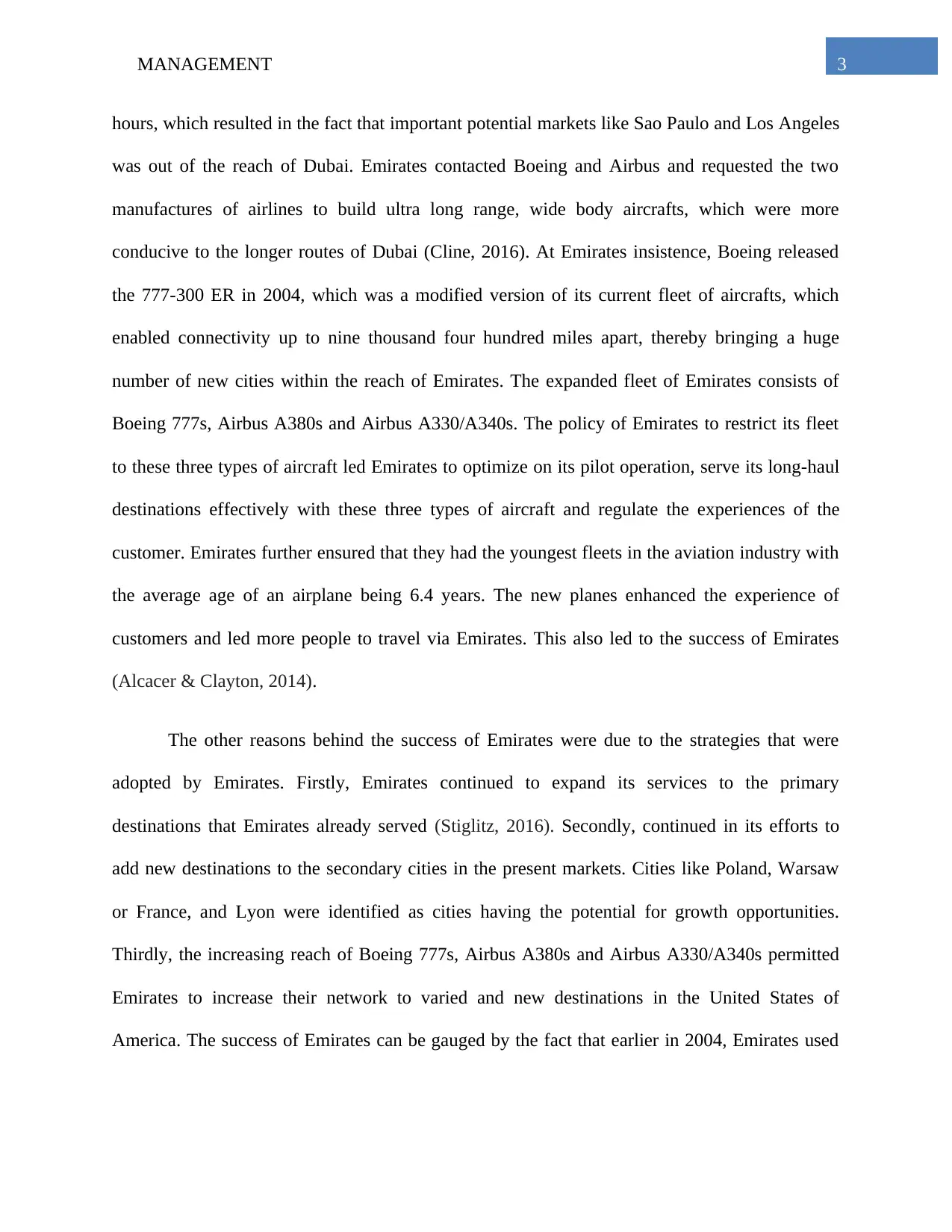
3MANAGEMENT
hours, which resulted in the fact that important potential markets like Sao Paulo and Los Angeles
was out of the reach of Dubai. Emirates contacted Boeing and Airbus and requested the two
manufactures of airlines to build ultra long range, wide body aircrafts, which were more
conducive to the longer routes of Dubai (Cline, 2016). At Emirates insistence, Boeing released
the 777-300 ER in 2004, which was a modified version of its current fleet of aircrafts, which
enabled connectivity up to nine thousand four hundred miles apart, thereby bringing a huge
number of new cities within the reach of Emirates. The expanded fleet of Emirates consists of
Boeing 777s, Airbus A380s and Airbus A330/A340s. The policy of Emirates to restrict its fleet
to these three types of aircraft led Emirates to optimize on its pilot operation, serve its long-haul
destinations effectively with these three types of aircraft and regulate the experiences of the
customer. Emirates further ensured that they had the youngest fleets in the aviation industry with
the average age of an airplane being 6.4 years. The new planes enhanced the experience of
customers and led more people to travel via Emirates. This also led to the success of Emirates
(Alcacer & Clayton, 2014).
The other reasons behind the success of Emirates were due to the strategies that were
adopted by Emirates. Firstly, Emirates continued to expand its services to the primary
destinations that Emirates already served (Stiglitz, 2016). Secondly, continued in its efforts to
add new destinations to the secondary cities in the present markets. Cities like Poland, Warsaw
or France, and Lyon were identified as cities having the potential for growth opportunities.
Thirdly, the increasing reach of Boeing 777s, Airbus A380s and Airbus A330/A340s permitted
Emirates to increase their network to varied and new destinations in the United States of
America. The success of Emirates can be gauged by the fact that earlier in 2004, Emirates used
hours, which resulted in the fact that important potential markets like Sao Paulo and Los Angeles
was out of the reach of Dubai. Emirates contacted Boeing and Airbus and requested the two
manufactures of airlines to build ultra long range, wide body aircrafts, which were more
conducive to the longer routes of Dubai (Cline, 2016). At Emirates insistence, Boeing released
the 777-300 ER in 2004, which was a modified version of its current fleet of aircrafts, which
enabled connectivity up to nine thousand four hundred miles apart, thereby bringing a huge
number of new cities within the reach of Emirates. The expanded fleet of Emirates consists of
Boeing 777s, Airbus A380s and Airbus A330/A340s. The policy of Emirates to restrict its fleet
to these three types of aircraft led Emirates to optimize on its pilot operation, serve its long-haul
destinations effectively with these three types of aircraft and regulate the experiences of the
customer. Emirates further ensured that they had the youngest fleets in the aviation industry with
the average age of an airplane being 6.4 years. The new planes enhanced the experience of
customers and led more people to travel via Emirates. This also led to the success of Emirates
(Alcacer & Clayton, 2014).
The other reasons behind the success of Emirates were due to the strategies that were
adopted by Emirates. Firstly, Emirates continued to expand its services to the primary
destinations that Emirates already served (Stiglitz, 2016). Secondly, continued in its efforts to
add new destinations to the secondary cities in the present markets. Cities like Poland, Warsaw
or France, and Lyon were identified as cities having the potential for growth opportunities.
Thirdly, the increasing reach of Boeing 777s, Airbus A380s and Airbus A330/A340s permitted
Emirates to increase their network to varied and new destinations in the United States of
America. The success of Emirates can be gauged by the fact that earlier in 2004, Emirates used
Paraphrase This Document
Need a fresh take? Get an instant paraphrase of this document with our AI Paraphraser
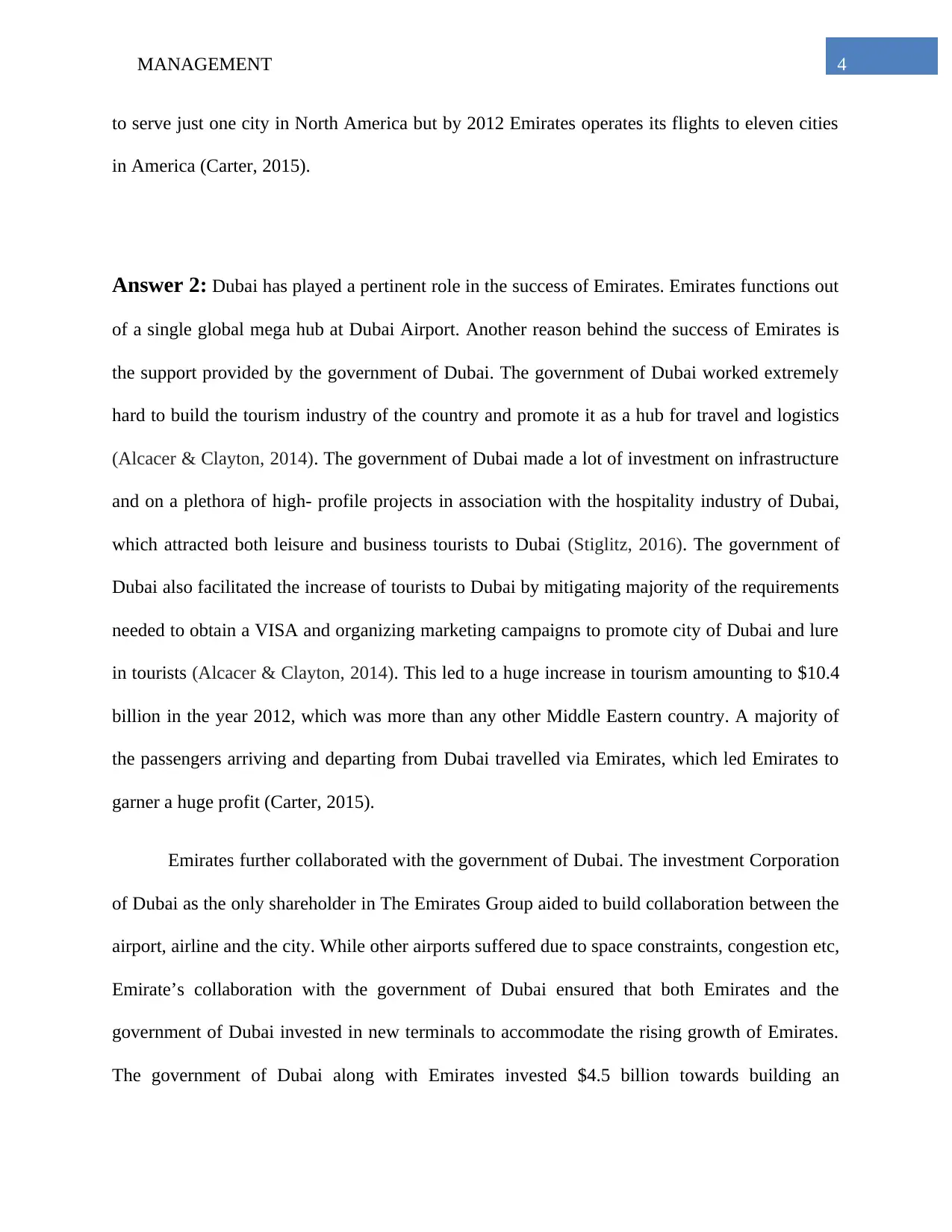
4MANAGEMENT
to serve just one city in North America but by 2012 Emirates operates its flights to eleven cities
in America (Carter, 2015).
Answer 2: Dubai has played a pertinent role in the success of Emirates. Emirates functions out
of a single global mega hub at Dubai Airport. Another reason behind the success of Emirates is
the support provided by the government of Dubai. The government of Dubai worked extremely
hard to build the tourism industry of the country and promote it as a hub for travel and logistics
(Alcacer & Clayton, 2014). The government of Dubai made a lot of investment on infrastructure
and on a plethora of high- profile projects in association with the hospitality industry of Dubai,
which attracted both leisure and business tourists to Dubai (Stiglitz, 2016). The government of
Dubai also facilitated the increase of tourists to Dubai by mitigating majority of the requirements
needed to obtain a VISA and organizing marketing campaigns to promote city of Dubai and lure
in tourists (Alcacer & Clayton, 2014). This led to a huge increase in tourism amounting to $10.4
billion in the year 2012, which was more than any other Middle Eastern country. A majority of
the passengers arriving and departing from Dubai travelled via Emirates, which led Emirates to
garner a huge profit (Carter, 2015).
Emirates further collaborated with the government of Dubai. The investment Corporation
of Dubai as the only shareholder in The Emirates Group aided to build collaboration between the
airport, airline and the city. While other airports suffered due to space constraints, congestion etc,
Emirate’s collaboration with the government of Dubai ensured that both Emirates and the
government of Dubai invested in new terminals to accommodate the rising growth of Emirates.
The government of Dubai along with Emirates invested $4.5 billion towards building an
to serve just one city in North America but by 2012 Emirates operates its flights to eleven cities
in America (Carter, 2015).
Answer 2: Dubai has played a pertinent role in the success of Emirates. Emirates functions out
of a single global mega hub at Dubai Airport. Another reason behind the success of Emirates is
the support provided by the government of Dubai. The government of Dubai worked extremely
hard to build the tourism industry of the country and promote it as a hub for travel and logistics
(Alcacer & Clayton, 2014). The government of Dubai made a lot of investment on infrastructure
and on a plethora of high- profile projects in association with the hospitality industry of Dubai,
which attracted both leisure and business tourists to Dubai (Stiglitz, 2016). The government of
Dubai also facilitated the increase of tourists to Dubai by mitigating majority of the requirements
needed to obtain a VISA and organizing marketing campaigns to promote city of Dubai and lure
in tourists (Alcacer & Clayton, 2014). This led to a huge increase in tourism amounting to $10.4
billion in the year 2012, which was more than any other Middle Eastern country. A majority of
the passengers arriving and departing from Dubai travelled via Emirates, which led Emirates to
garner a huge profit (Carter, 2015).
Emirates further collaborated with the government of Dubai. The investment Corporation
of Dubai as the only shareholder in The Emirates Group aided to build collaboration between the
airport, airline and the city. While other airports suffered due to space constraints, congestion etc,
Emirate’s collaboration with the government of Dubai ensured that both Emirates and the
government of Dubai invested in new terminals to accommodate the rising growth of Emirates.
The government of Dubai along with Emirates invested $4.5 billion towards building an
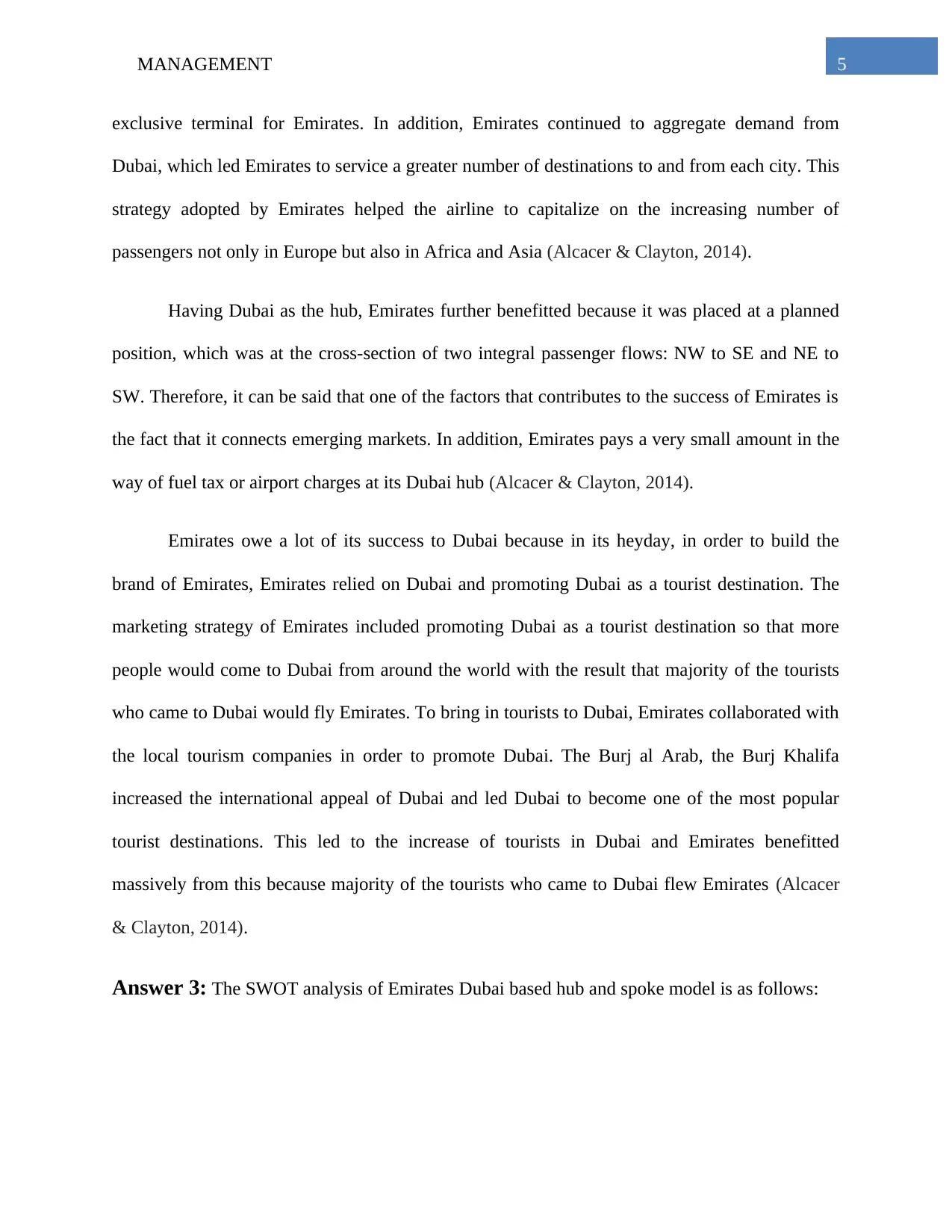
5MANAGEMENT
exclusive terminal for Emirates. In addition, Emirates continued to aggregate demand from
Dubai, which led Emirates to service a greater number of destinations to and from each city. This
strategy adopted by Emirates helped the airline to capitalize on the increasing number of
passengers not only in Europe but also in Africa and Asia (Alcacer & Clayton, 2014).
Having Dubai as the hub, Emirates further benefitted because it was placed at a planned
position, which was at the cross-section of two integral passenger flows: NW to SE and NE to
SW. Therefore, it can be said that one of the factors that contributes to the success of Emirates is
the fact that it connects emerging markets. In addition, Emirates pays a very small amount in the
way of fuel tax or airport charges at its Dubai hub (Alcacer & Clayton, 2014).
Emirates owe a lot of its success to Dubai because in its heyday, in order to build the
brand of Emirates, Emirates relied on Dubai and promoting Dubai as a tourist destination. The
marketing strategy of Emirates included promoting Dubai as a tourist destination so that more
people would come to Dubai from around the world with the result that majority of the tourists
who came to Dubai would fly Emirates. To bring in tourists to Dubai, Emirates collaborated with
the local tourism companies in order to promote Dubai. The Burj al Arab, the Burj Khalifa
increased the international appeal of Dubai and led Dubai to become one of the most popular
tourist destinations. This led to the increase of tourists in Dubai and Emirates benefitted
massively from this because majority of the tourists who came to Dubai flew Emirates (Alcacer
& Clayton, 2014).
Answer 3: The SWOT analysis of Emirates Dubai based hub and spoke model is as follows:
exclusive terminal for Emirates. In addition, Emirates continued to aggregate demand from
Dubai, which led Emirates to service a greater number of destinations to and from each city. This
strategy adopted by Emirates helped the airline to capitalize on the increasing number of
passengers not only in Europe but also in Africa and Asia (Alcacer & Clayton, 2014).
Having Dubai as the hub, Emirates further benefitted because it was placed at a planned
position, which was at the cross-section of two integral passenger flows: NW to SE and NE to
SW. Therefore, it can be said that one of the factors that contributes to the success of Emirates is
the fact that it connects emerging markets. In addition, Emirates pays a very small amount in the
way of fuel tax or airport charges at its Dubai hub (Alcacer & Clayton, 2014).
Emirates owe a lot of its success to Dubai because in its heyday, in order to build the
brand of Emirates, Emirates relied on Dubai and promoting Dubai as a tourist destination. The
marketing strategy of Emirates included promoting Dubai as a tourist destination so that more
people would come to Dubai from around the world with the result that majority of the tourists
who came to Dubai would fly Emirates. To bring in tourists to Dubai, Emirates collaborated with
the local tourism companies in order to promote Dubai. The Burj al Arab, the Burj Khalifa
increased the international appeal of Dubai and led Dubai to become one of the most popular
tourist destinations. This led to the increase of tourists in Dubai and Emirates benefitted
massively from this because majority of the tourists who came to Dubai flew Emirates (Alcacer
& Clayton, 2014).
Answer 3: The SWOT analysis of Emirates Dubai based hub and spoke model is as follows:
⊘ This is a preview!⊘
Do you want full access?
Subscribe today to unlock all pages.

Trusted by 1+ million students worldwide
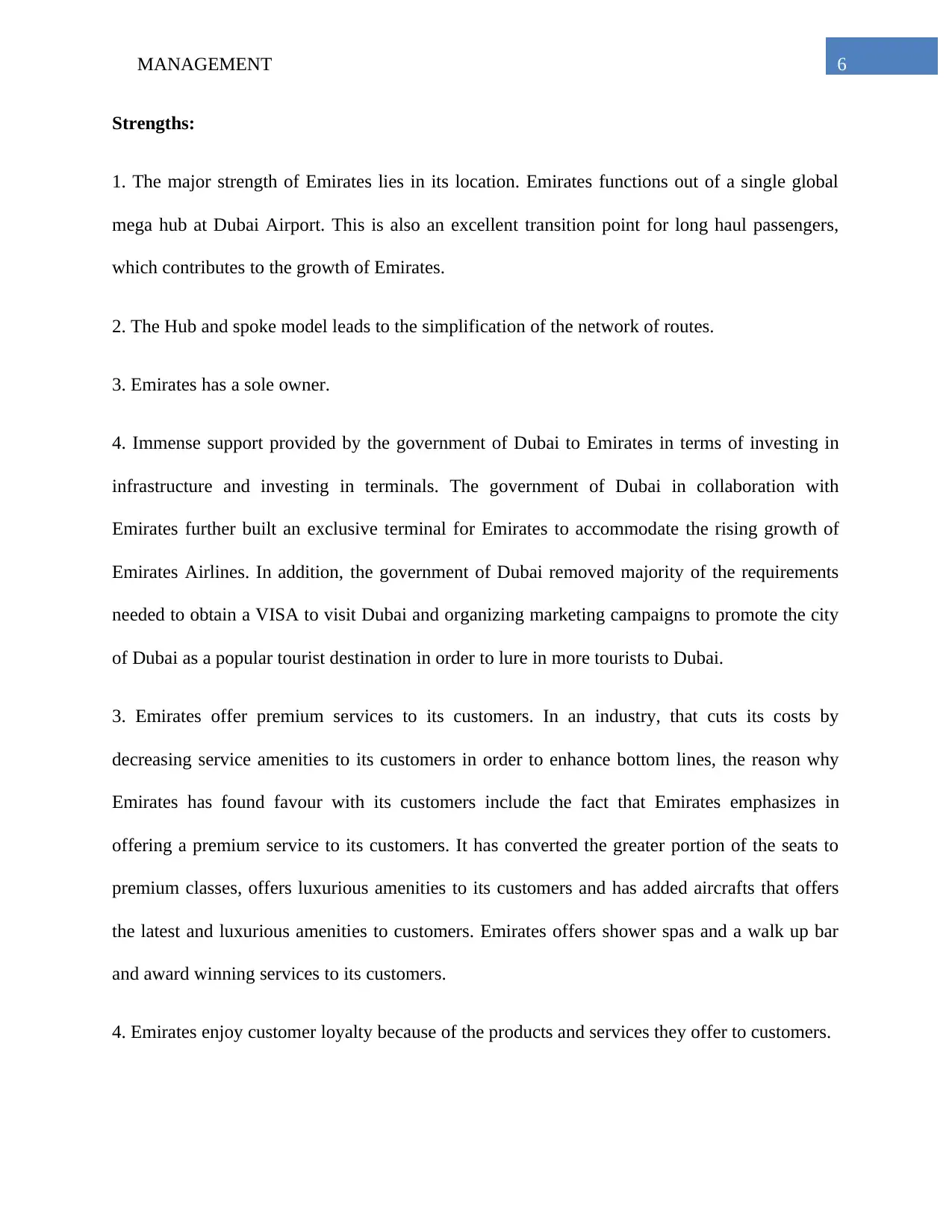
6MANAGEMENT
Strengths:
1. The major strength of Emirates lies in its location. Emirates functions out of a single global
mega hub at Dubai Airport. This is also an excellent transition point for long haul passengers,
which contributes to the growth of Emirates.
2. The Hub and spoke model leads to the simplification of the network of routes.
3. Emirates has a sole owner.
4. Immense support provided by the government of Dubai to Emirates in terms of investing in
infrastructure and investing in terminals. The government of Dubai in collaboration with
Emirates further built an exclusive terminal for Emirates to accommodate the rising growth of
Emirates Airlines. In addition, the government of Dubai removed majority of the requirements
needed to obtain a VISA to visit Dubai and organizing marketing campaigns to promote the city
of Dubai as a popular tourist destination in order to lure in more tourists to Dubai.
3. Emirates offer premium services to its customers. In an industry, that cuts its costs by
decreasing service amenities to its customers in order to enhance bottom lines, the reason why
Emirates has found favour with its customers include the fact that Emirates emphasizes in
offering a premium service to its customers. It has converted the greater portion of the seats to
premium classes, offers luxurious amenities to its customers and has added aircrafts that offers
the latest and luxurious amenities to customers. Emirates offers shower spas and a walk up bar
and award winning services to its customers.
4. Emirates enjoy customer loyalty because of the products and services they offer to customers.
Strengths:
1. The major strength of Emirates lies in its location. Emirates functions out of a single global
mega hub at Dubai Airport. This is also an excellent transition point for long haul passengers,
which contributes to the growth of Emirates.
2. The Hub and spoke model leads to the simplification of the network of routes.
3. Emirates has a sole owner.
4. Immense support provided by the government of Dubai to Emirates in terms of investing in
infrastructure and investing in terminals. The government of Dubai in collaboration with
Emirates further built an exclusive terminal for Emirates to accommodate the rising growth of
Emirates Airlines. In addition, the government of Dubai removed majority of the requirements
needed to obtain a VISA to visit Dubai and organizing marketing campaigns to promote the city
of Dubai as a popular tourist destination in order to lure in more tourists to Dubai.
3. Emirates offer premium services to its customers. In an industry, that cuts its costs by
decreasing service amenities to its customers in order to enhance bottom lines, the reason why
Emirates has found favour with its customers include the fact that Emirates emphasizes in
offering a premium service to its customers. It has converted the greater portion of the seats to
premium classes, offers luxurious amenities to its customers and has added aircrafts that offers
the latest and luxurious amenities to customers. Emirates offers shower spas and a walk up bar
and award winning services to its customers.
4. Emirates enjoy customer loyalty because of the products and services they offer to customers.
Paraphrase This Document
Need a fresh take? Get an instant paraphrase of this document with our AI Paraphraser
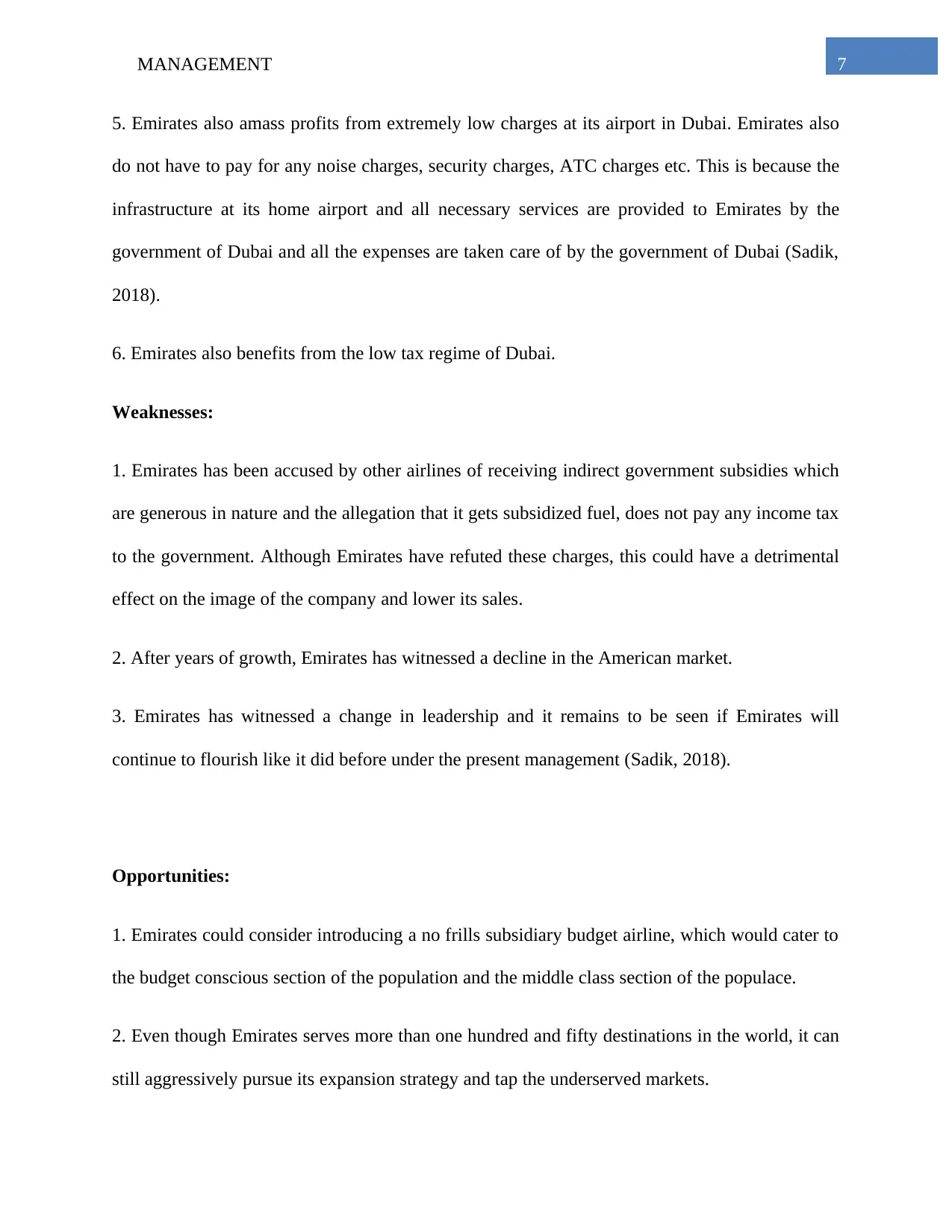
7MANAGEMENT
5. Emirates also amass profits from extremely low charges at its airport in Dubai. Emirates also
do not have to pay for any noise charges, security charges, ATC charges etc. This is because the
infrastructure at its home airport and all necessary services are provided to Emirates by the
government of Dubai and all the expenses are taken care of by the government of Dubai (Sadik,
2018).
6. Emirates also benefits from the low tax regime of Dubai.
Weaknesses:
1. Emirates has been accused by other airlines of receiving indirect government subsidies which
are generous in nature and the allegation that it gets subsidized fuel, does not pay any income tax
to the government. Although Emirates have refuted these charges, this could have a detrimental
effect on the image of the company and lower its sales.
2. After years of growth, Emirates has witnessed a decline in the American market.
3. Emirates has witnessed a change in leadership and it remains to be seen if Emirates will
continue to flourish like it did before under the present management (Sadik, 2018).
Opportunities:
1. Emirates could consider introducing a no frills subsidiary budget airline, which would cater to
the budget conscious section of the population and the middle class section of the populace.
2. Even though Emirates serves more than one hundred and fifty destinations in the world, it can
still aggressively pursue its expansion strategy and tap the underserved markets.
5. Emirates also amass profits from extremely low charges at its airport in Dubai. Emirates also
do not have to pay for any noise charges, security charges, ATC charges etc. This is because the
infrastructure at its home airport and all necessary services are provided to Emirates by the
government of Dubai and all the expenses are taken care of by the government of Dubai (Sadik,
2018).
6. Emirates also benefits from the low tax regime of Dubai.
Weaknesses:
1. Emirates has been accused by other airlines of receiving indirect government subsidies which
are generous in nature and the allegation that it gets subsidized fuel, does not pay any income tax
to the government. Although Emirates have refuted these charges, this could have a detrimental
effect on the image of the company and lower its sales.
2. After years of growth, Emirates has witnessed a decline in the American market.
3. Emirates has witnessed a change in leadership and it remains to be seen if Emirates will
continue to flourish like it did before under the present management (Sadik, 2018).
Opportunities:
1. Emirates could consider introducing a no frills subsidiary budget airline, which would cater to
the budget conscious section of the population and the middle class section of the populace.
2. Even though Emirates serves more than one hundred and fifty destinations in the world, it can
still aggressively pursue its expansion strategy and tap the underserved markets.
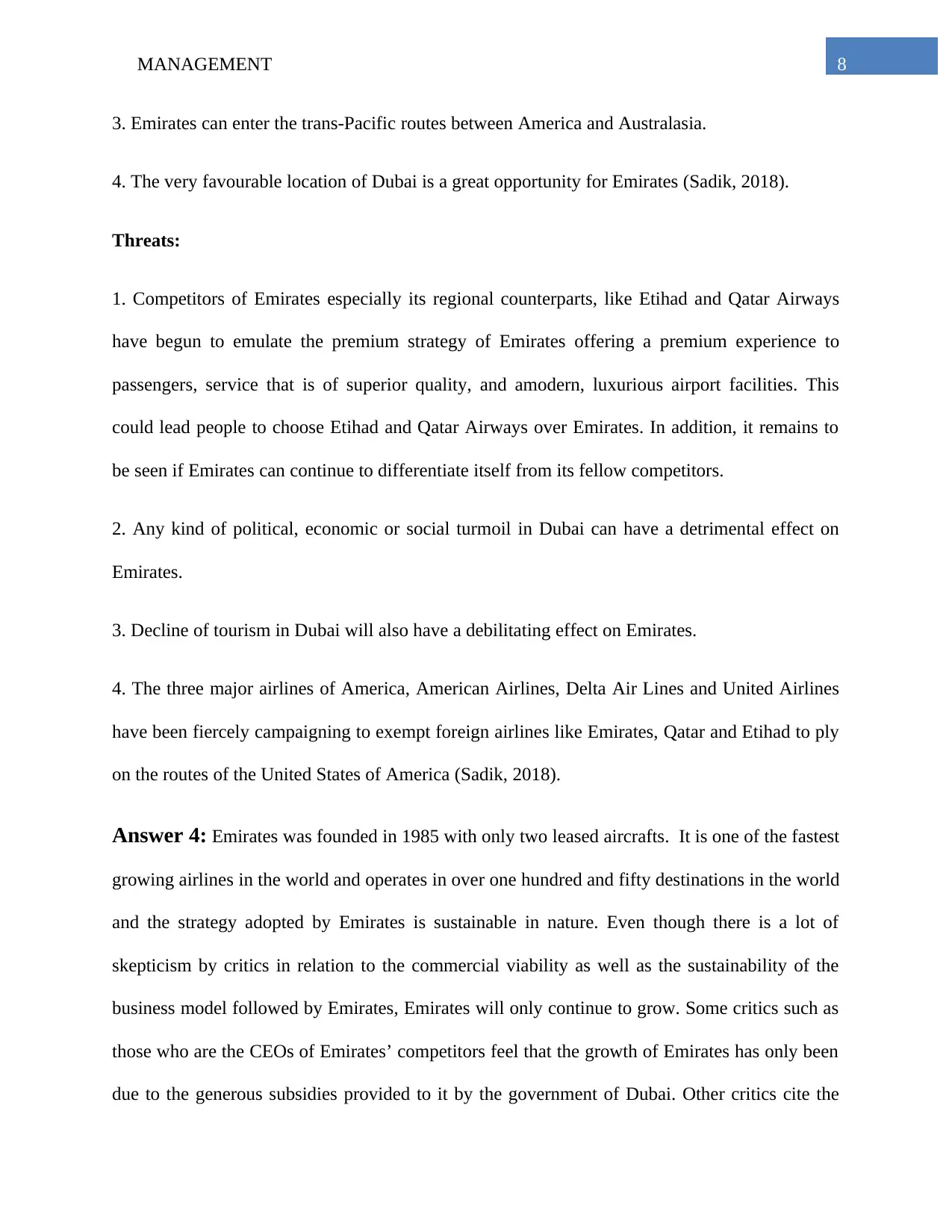
8MANAGEMENT
3. Emirates can enter the trans-Pacific routes between America and Australasia.
4. The very favourable location of Dubai is a great opportunity for Emirates (Sadik, 2018).
Threats:
1. Competitors of Emirates especially its regional counterparts, like Etihad and Qatar Airways
have begun to emulate the premium strategy of Emirates offering a premium experience to
passengers, service that is of superior quality, and amodern, luxurious airport facilities. This
could lead people to choose Etihad and Qatar Airways over Emirates. In addition, it remains to
be seen if Emirates can continue to differentiate itself from its fellow competitors.
2. Any kind of political, economic or social turmoil in Dubai can have a detrimental effect on
Emirates.
3. Decline of tourism in Dubai will also have a debilitating effect on Emirates.
4. The three major airlines of America, American Airlines, Delta Air Lines and United Airlines
have been fiercely campaigning to exempt foreign airlines like Emirates, Qatar and Etihad to ply
on the routes of the United States of America (Sadik, 2018).
Answer 4: Emirates was founded in 1985 with only two leased aircrafts. It is one of the fastest
growing airlines in the world and operates in over one hundred and fifty destinations in the world
and the strategy adopted by Emirates is sustainable in nature. Even though there is a lot of
skepticism by critics in relation to the commercial viability as well as the sustainability of the
business model followed by Emirates, Emirates will only continue to grow. Some critics such as
those who are the CEOs of Emirates’ competitors feel that the growth of Emirates has only been
due to the generous subsidies provided to it by the government of Dubai. Other critics cite the
3. Emirates can enter the trans-Pacific routes between America and Australasia.
4. The very favourable location of Dubai is a great opportunity for Emirates (Sadik, 2018).
Threats:
1. Competitors of Emirates especially its regional counterparts, like Etihad and Qatar Airways
have begun to emulate the premium strategy of Emirates offering a premium experience to
passengers, service that is of superior quality, and amodern, luxurious airport facilities. This
could lead people to choose Etihad and Qatar Airways over Emirates. In addition, it remains to
be seen if Emirates can continue to differentiate itself from its fellow competitors.
2. Any kind of political, economic or social turmoil in Dubai can have a detrimental effect on
Emirates.
3. Decline of tourism in Dubai will also have a debilitating effect on Emirates.
4. The three major airlines of America, American Airlines, Delta Air Lines and United Airlines
have been fiercely campaigning to exempt foreign airlines like Emirates, Qatar and Etihad to ply
on the routes of the United States of America (Sadik, 2018).
Answer 4: Emirates was founded in 1985 with only two leased aircrafts. It is one of the fastest
growing airlines in the world and operates in over one hundred and fifty destinations in the world
and the strategy adopted by Emirates is sustainable in nature. Even though there is a lot of
skepticism by critics in relation to the commercial viability as well as the sustainability of the
business model followed by Emirates, Emirates will only continue to grow. Some critics such as
those who are the CEOs of Emirates’ competitors feel that the growth of Emirates has only been
due to the generous subsidies provided to it by the government of Dubai. Other critics cite the
⊘ This is a preview!⊘
Do you want full access?
Subscribe today to unlock all pages.

Trusted by 1+ million students worldwide
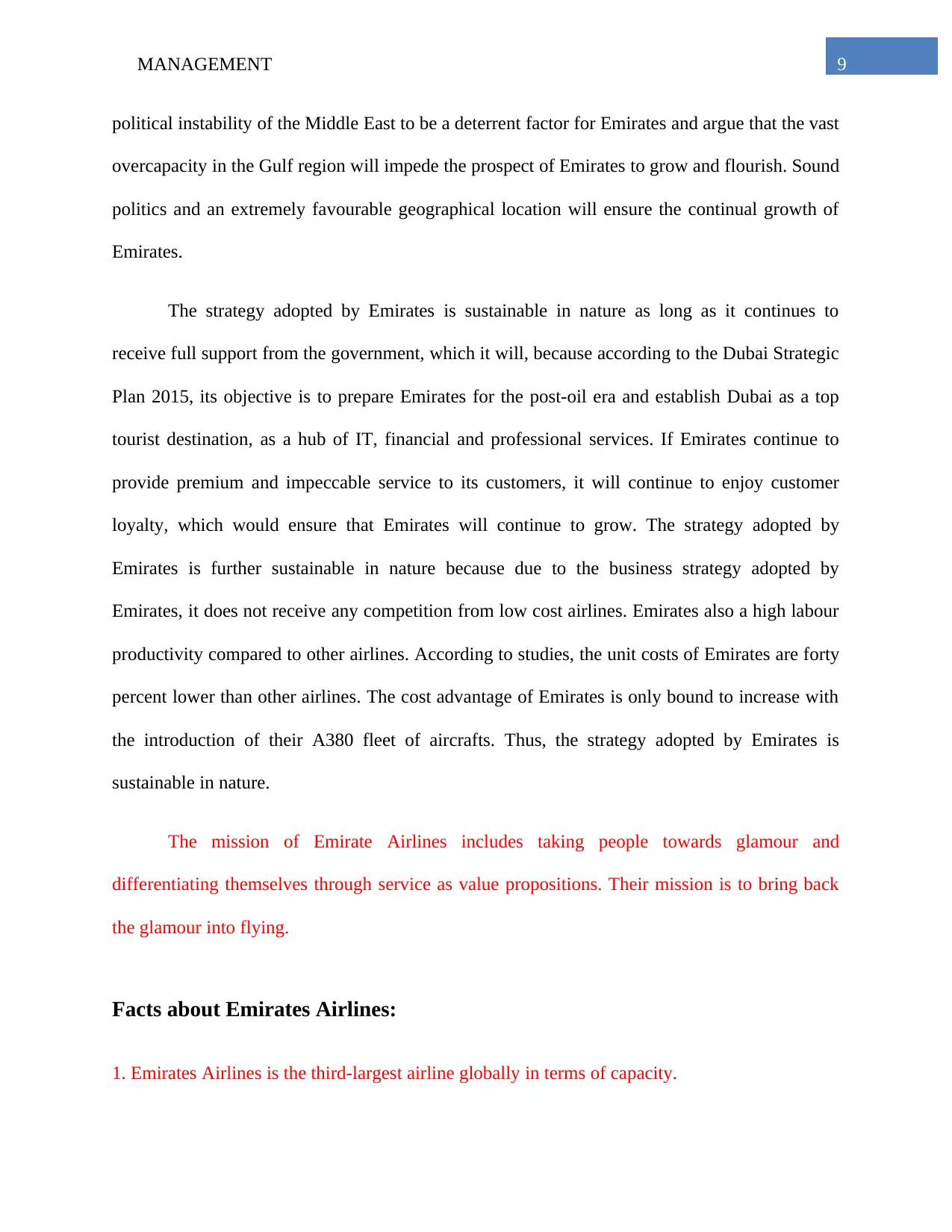
9MANAGEMENT
political instability of the Middle East to be a deterrent factor for Emirates and argue that the vast
overcapacity in the Gulf region will impede the prospect of Emirates to grow and flourish. Sound
politics and an extremely favourable geographical location will ensure the continual growth of
Emirates.
The strategy adopted by Emirates is sustainable in nature as long as it continues to
receive full support from the government, which it will, because according to the Dubai Strategic
Plan 2015, its objective is to prepare Emirates for the post-oil era and establish Dubai as a top
tourist destination, as a hub of IT, financial and professional services. If Emirates continue to
provide premium and impeccable service to its customers, it will continue to enjoy customer
loyalty, which would ensure that Emirates will continue to grow. The strategy adopted by
Emirates is further sustainable in nature because due to the business strategy adopted by
Emirates, it does not receive any competition from low cost airlines. Emirates also a high labour
productivity compared to other airlines. According to studies, the unit costs of Emirates are forty
percent lower than other airlines. The cost advantage of Emirates is only bound to increase with
the introduction of their A380 fleet of aircrafts. Thus, the strategy adopted by Emirates is
sustainable in nature.
The mission of Emirate Airlines includes taking people towards glamour and
differentiating themselves through service as value propositions. Their mission is to bring back
the glamour into flying.
Facts about Emirates Airlines:
1. Emirates Airlines is the third-largest airline globally in terms of capacity.
political instability of the Middle East to be a deterrent factor for Emirates and argue that the vast
overcapacity in the Gulf region will impede the prospect of Emirates to grow and flourish. Sound
politics and an extremely favourable geographical location will ensure the continual growth of
Emirates.
The strategy adopted by Emirates is sustainable in nature as long as it continues to
receive full support from the government, which it will, because according to the Dubai Strategic
Plan 2015, its objective is to prepare Emirates for the post-oil era and establish Dubai as a top
tourist destination, as a hub of IT, financial and professional services. If Emirates continue to
provide premium and impeccable service to its customers, it will continue to enjoy customer
loyalty, which would ensure that Emirates will continue to grow. The strategy adopted by
Emirates is further sustainable in nature because due to the business strategy adopted by
Emirates, it does not receive any competition from low cost airlines. Emirates also a high labour
productivity compared to other airlines. According to studies, the unit costs of Emirates are forty
percent lower than other airlines. The cost advantage of Emirates is only bound to increase with
the introduction of their A380 fleet of aircrafts. Thus, the strategy adopted by Emirates is
sustainable in nature.
The mission of Emirate Airlines includes taking people towards glamour and
differentiating themselves through service as value propositions. Their mission is to bring back
the glamour into flying.
Facts about Emirates Airlines:
1. Emirates Airlines is the third-largest airline globally in terms of capacity.
Paraphrase This Document
Need a fresh take? Get an instant paraphrase of this document with our AI Paraphraser
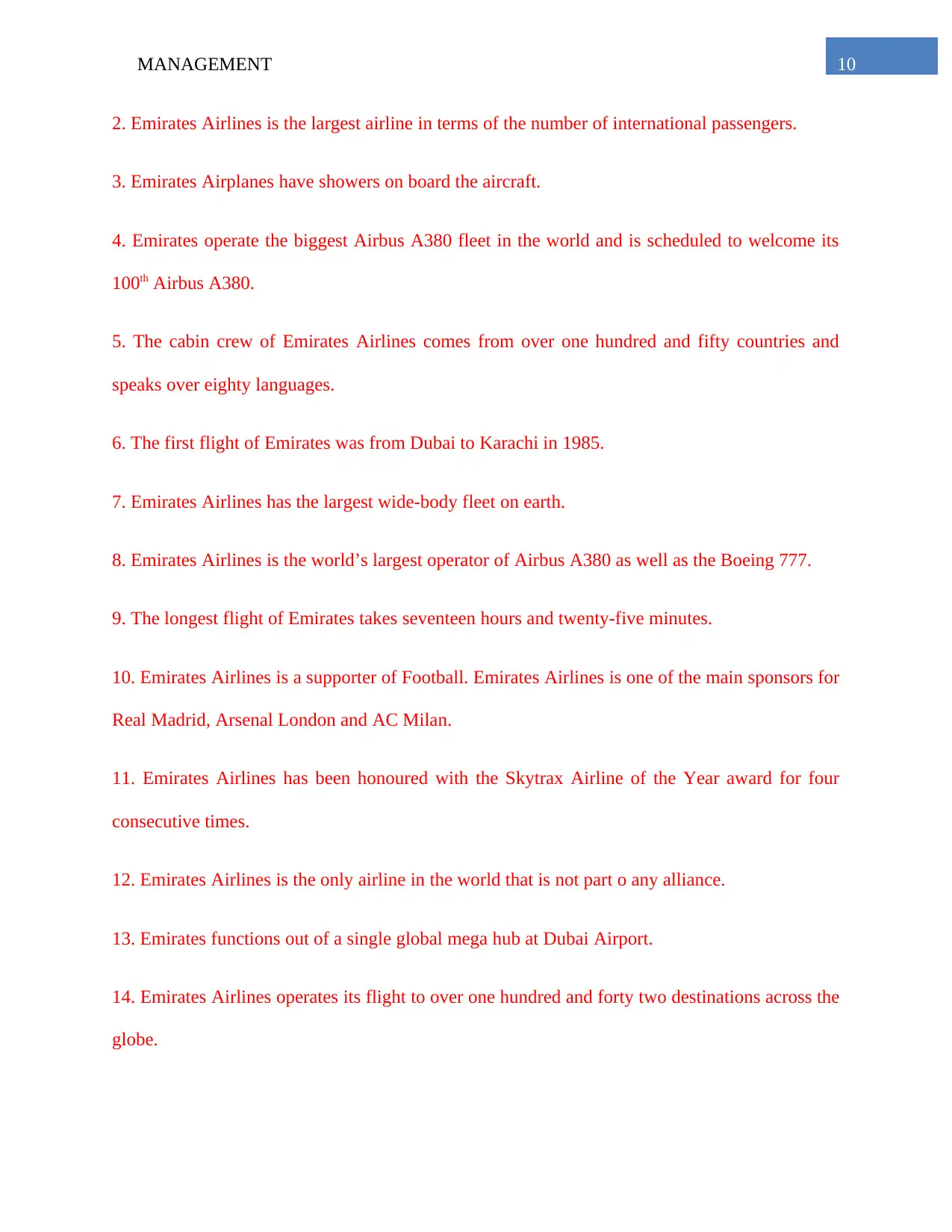
10MANAGEMENT
2. Emirates Airlines is the largest airline in terms of the number of international passengers.
3. Emirates Airplanes have showers on board the aircraft.
4. Emirates operate the biggest Airbus A380 fleet in the world and is scheduled to welcome its
100th Airbus A380.
5. The cabin crew of Emirates Airlines comes from over one hundred and fifty countries and
speaks over eighty languages.
6. The first flight of Emirates was from Dubai to Karachi in 1985.
7. Emirates Airlines has the largest wide-body fleet on earth.
8. Emirates Airlines is the world’s largest operator of Airbus A380 as well as the Boeing 777.
9. The longest flight of Emirates takes seventeen hours and twenty-five minutes.
10. Emirates Airlines is a supporter of Football. Emirates Airlines is one of the main sponsors for
Real Madrid, Arsenal London and AC Milan.
11. Emirates Airlines has been honoured with the Skytrax Airline of the Year award for four
consecutive times.
12. Emirates Airlines is the only airline in the world that is not part o any alliance.
13. Emirates functions out of a single global mega hub at Dubai Airport.
14. Emirates Airlines operates its flight to over one hundred and forty two destinations across the
globe.
2. Emirates Airlines is the largest airline in terms of the number of international passengers.
3. Emirates Airplanes have showers on board the aircraft.
4. Emirates operate the biggest Airbus A380 fleet in the world and is scheduled to welcome its
100th Airbus A380.
5. The cabin crew of Emirates Airlines comes from over one hundred and fifty countries and
speaks over eighty languages.
6. The first flight of Emirates was from Dubai to Karachi in 1985.
7. Emirates Airlines has the largest wide-body fleet on earth.
8. Emirates Airlines is the world’s largest operator of Airbus A380 as well as the Boeing 777.
9. The longest flight of Emirates takes seventeen hours and twenty-five minutes.
10. Emirates Airlines is a supporter of Football. Emirates Airlines is one of the main sponsors for
Real Madrid, Arsenal London and AC Milan.
11. Emirates Airlines has been honoured with the Skytrax Airline of the Year award for four
consecutive times.
12. Emirates Airlines is the only airline in the world that is not part o any alliance.
13. Emirates functions out of a single global mega hub at Dubai Airport.
14. Emirates Airlines operates its flight to over one hundred and forty two destinations across the
globe.
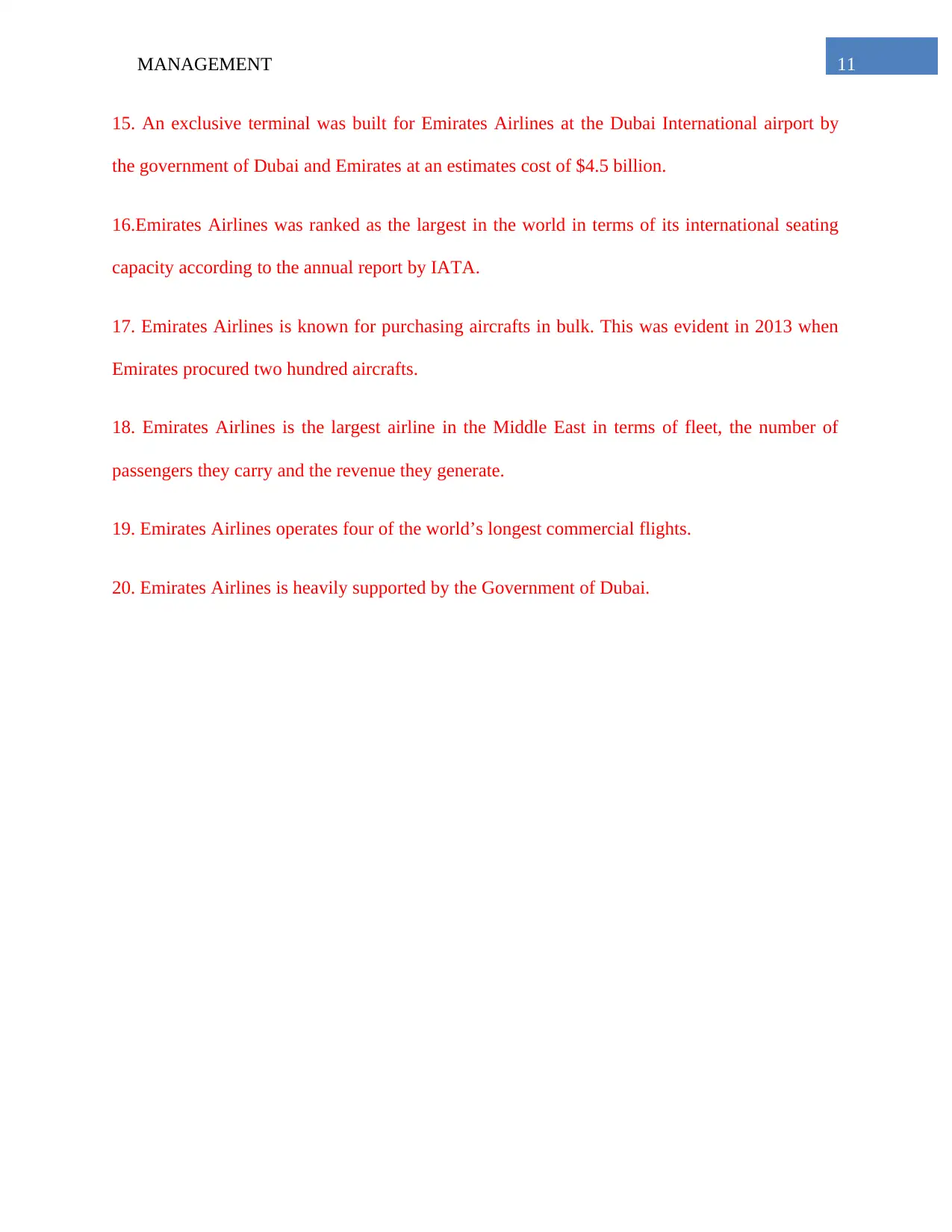
11MANAGEMENT
15. An exclusive terminal was built for Emirates Airlines at the Dubai International airport by
the government of Dubai and Emirates at an estimates cost of $4.5 billion.
16.Emirates Airlines was ranked as the largest in the world in terms of its international seating
capacity according to the annual report by IATA.
17. Emirates Airlines is known for purchasing aircrafts in bulk. This was evident in 2013 when
Emirates procured two hundred aircrafts.
18. Emirates Airlines is the largest airline in the Middle East in terms of fleet, the number of
passengers they carry and the revenue they generate.
19. Emirates Airlines operates four of the world’s longest commercial flights.
20. Emirates Airlines is heavily supported by the Government of Dubai.
15. An exclusive terminal was built for Emirates Airlines at the Dubai International airport by
the government of Dubai and Emirates at an estimates cost of $4.5 billion.
16.Emirates Airlines was ranked as the largest in the world in terms of its international seating
capacity according to the annual report by IATA.
17. Emirates Airlines is known for purchasing aircrafts in bulk. This was evident in 2013 when
Emirates procured two hundred aircrafts.
18. Emirates Airlines is the largest airline in the Middle East in terms of fleet, the number of
passengers they carry and the revenue they generate.
19. Emirates Airlines operates four of the world’s longest commercial flights.
20. Emirates Airlines is heavily supported by the Government of Dubai.
⊘ This is a preview!⊘
Do you want full access?
Subscribe today to unlock all pages.

Trusted by 1+ million students worldwide
1 out of 16
Related Documents
Your All-in-One AI-Powered Toolkit for Academic Success.
+13062052269
info@desklib.com
Available 24*7 on WhatsApp / Email
![[object Object]](/_next/static/media/star-bottom.7253800d.svg)
Unlock your academic potential
Copyright © 2020–2025 A2Z Services. All Rights Reserved. Developed and managed by ZUCOL.





